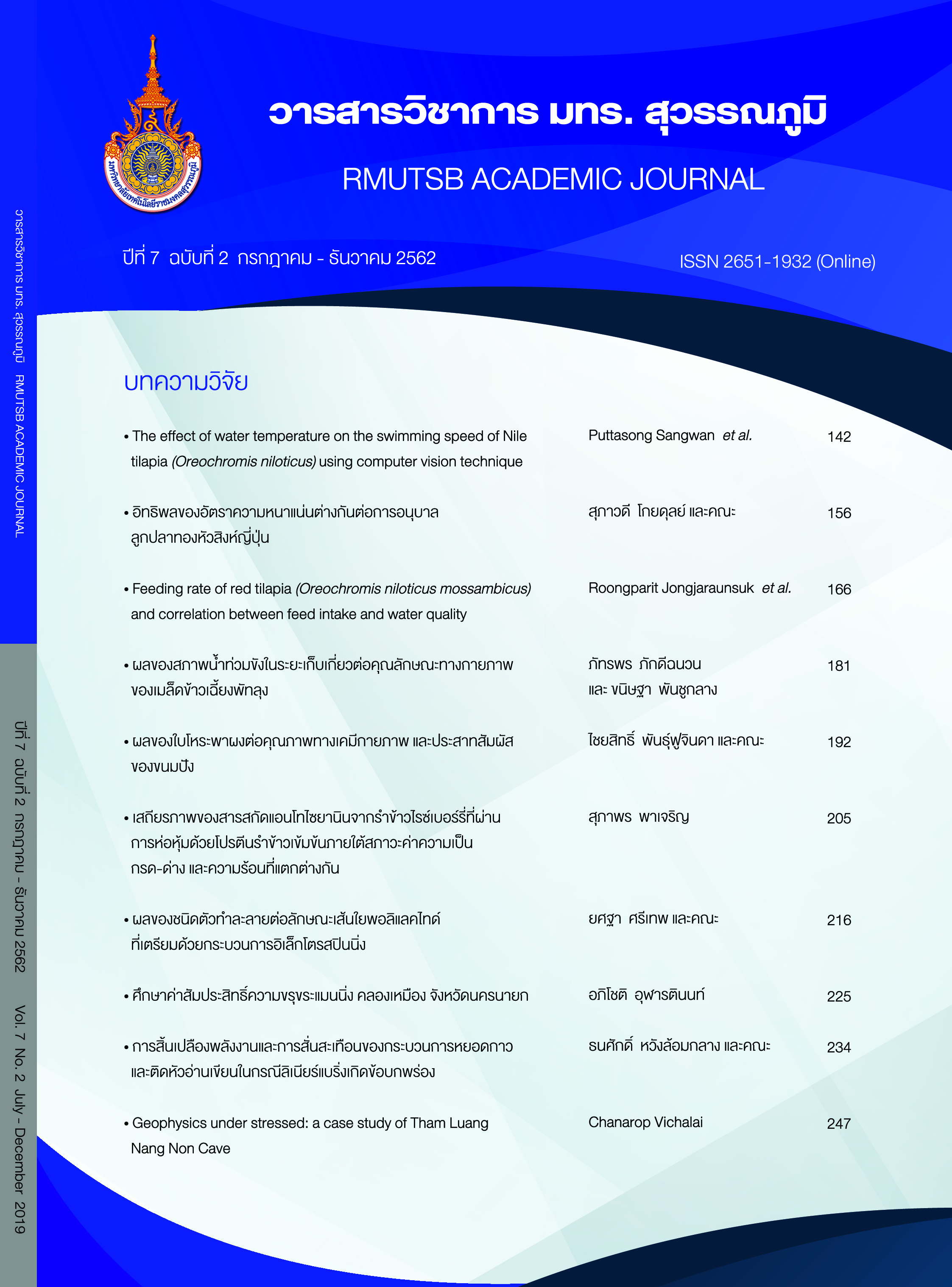อิทธิพลของอัตราความหนาแน่นต่างกันต่อการอนุบาลลูกปลาทองหัวสิงห์ญี่ปุ่น
Main Article Content
บทคัดย่อ
อิทธิพลของความหนาแน่นต่างกันต่อการอนุบาลลูกปลาทองหัวสิงห์ญี่ปุ่น ที่มีน้ำหนักเฉลี่ยเริ่มต้น 2.49±0.03 กรัมต่อตัว และความยาวเฉลี่ยเริ่มต้น 4.67±0.07 เซนติเมตรต่อตัว ต่อสมรรถนะด้านน้ำหนัก ความยาวของปลา น้ำหนักที่เพิ่มขึ้นต่อวัน การเจริญเติบโต อัตราการรอดตาย และต้นทุนค่าอาหารต่อปลาหนึ่งตัว วางแผนการทดลองแบบสุ่มตลอด (completely randomized design; CRD) แบ่งเป็น 3 ชุดการทดลอง (treatment) คือ ความหนาแน่น 20, 30 และ 40 ตัวต่อตารางเมตร แต่ละชุดการทดลองมี 3 ซ้ำ ทดลองในถังไฟเบอร์ รูปทรงกระบอกที่มีปริมาตรน้ำ 310 ลิตร ระยะเวลาการทดลอง 6 สัปดาห์ เมื่อสิ้นสุดการทดลองพบว่า การเจริญเติบโตทางด้านน้ำหนัก และน้ำหนักเพิ่มต่อวัน มีความแตกต่างกันทางสถิติอย่างมีนัยสำคัญ (P<0.05) โดยลูกปลาทองที่เลี้ยงในอัตราความหนาแน่น 20 ตัวต่อตารางเมตร (น้ำหนักเฉลี่ยสุดท้าย 10.40±0.01 กรัมต่อตัว) และ 30 ตัวต่อตารางเมตร (น้ำหนักเฉลี่ยสุดท้าย 10.33±0.06 กรัมต่อตัว) ตัวต่อตารางเมตร เจริญเติบโตดีกว่าอัตราความหนาแน่น 40 ตัวต่อตารางเมตร (น้ำหนักเฉลี่ยสุดท้าย 10.10±0.01 กรัมต่อตัว) ต้นทุนค่าอาหารต่อปลา 1 ตัว พบว่า ทุกชุดการทดลองไม่มีความแตกต่างกันทางสถิติ (P>0.05) มีค่าอยู่ในช่วง 0.64±0.01-0.67±0.03 บาทต่อตัว อัตราการรอดตายไม่มีความแตกต่างกันทางสถิติ (P>0.05) ทุกชุดการทดลองมีค่าเท่ากับ 100 เปอร์เซ็นต์ และค่าคุณภาพน้ำเหมาะสมต่อการเจริญเติบโตของลูกปลาทอง อัตราความหนาแน่นที่เหมาะสมสำหรับการอนุบาลลูกปลาทอง 30 ตัวต่อตารางเมตร
Article Details
ต้นฉบับที่ได้รับการตีพิมพ์ถือเป็นสิทธิของเจ้าของต้นฉบับและของวารสารวิชาการ มทร.สุวรรณภูมิ เนื้อหาบทความในวารสารเป็นแนวคิดของผู้แต่ง มิใช่เป็นความคิดเห็นของคณะกรรมการการจัดทำวารสาร และมิใช่ความรับผิดชอบของมหาวิทยาลัยเทคโนโลยีราชมงคลสุวรรณภูมิ
เอกสารอ้างอิง
Choomthi, A., Soonthornvipat, P., & Thongkhamchum, S. (2011). Cage culture of cobra snakehead (Channa marulius Hamilton, 1822) at different stocking density. Lampang: Inland Fisheries Research and Development Bureau. (in Thai)
Costas, B., Aragão, C., Mancera, J. M., Dinis, M. T., & Conceição, L. E. C. (2008). High stocking density induces crowding stress and affects amino acid metabolism in Senegalese sole Solea senegalensis (Kaup 1858) juveniles. Aquaculture Research, 39, 1-9.
De las Heras, V., Martos-Sitcha, J. A, Yúfera, M., Mancera, J. M., & Martínez-Rodríguez, G. (2015). Influence of stocking density on growth, metabolism and stress of thick-lipped grey mullet (Chelon labrosus) juveniles. Aquaculture, 448, 29-37.
Feldlite, M., & Milstein, A. (2000). Effect of density on survival and growth of cyprinid fish fry. Aquaculture Int., 7(6), 399-411.
Herrera, M., Vargas-Chacoff, L., Hachero, I., Ruiz-Jarabo, I., Rodiles, A., Navas, J. I., & Mancera, J. M. (2009). Physiological responses of juvenile wedge sole Dicologoglossa cuneate (Moreau) to high stocking density. Aquaculture Research, 40(7), 790-797.
Kansar, R. & Salim, M. (2006). Effects of water temperature on the growth performance and feed conversion ratio of Labeo rohita. Pakistan Vet. J., 26(3), 105-108.
Koydon, S. (2018). Water quality analysis for aquaculture. Pra Nakorn Si Ayutthaya, Huntra: Fisheries Science section, Faculty of Agricultural and Argo-Industry, Rajamangala University of Technology Suvarnaphumi. (in Thai)
Laiz-Carrión, R., Viana, I. R., Cejas, J. R., Ruiz-Jarabo, I., Jerez, S., Martos-SItcha, J. A., Almansa, E., & Mancera, J. M. (2012). Influence of food deprivation and high stocking density on energetic metabolism and stress response in red porgy, Pagrus pagrus L. Aquaculture International, 20(3), 585-599.
Li, D., Liu, Z., & Xie, C. (2012). Effect of stocking density on growth and serum concentrations of thyroid hormones and cortisol in Amur sturgeon, Acipenser schrenckii. Fish Physiol. Biochem, 38(2), 511-520.
Mozes N., Eshchar, M., Conijeski, D., Fediuk, M., & Ashkenaz, A. (2003). Marine recirculating systems in Israel-performance, production cost analysis and rationale for desert conditions. Israel Journal Aquaculture-Bamidgeh, 55(4), 274-282.
National Bureau of Agricultural Commodity and Food Standards (ACFS). (2016). Good aquaculture practices for freshwater animal farm. Thai Agricultural Standard TAS 7417 (G)-2016. Bangkok: National Bureau of Agricultural Commodity and Food Standards. (in Thai)
Person-Le Ruyet, L., Buchet, V., Vincent, B., Le Delliou, H., & Quéméner, L. (2006). Effects of temperature on the growth of pollack (Pollachius pollachius) juveniles. Aquaculture, 251(2-4), 340-345.
Qin, J. G., & Fast, A. W. (1998). Effects of temperature, size and density on culture performance of snakehead, Channa striatus (Bloch), fed formulated feed. Aquaculture Research, 29, 299-303.
Rothbard, S., & Yaron, Z. (1995). Carps (Cyprinidae). In N. R. Bromadge & R. J. Roberts (Eds.), Broodstock management and egg and larval quality (pp. 321-352). Oxford, UK.: Blackwell Science.
Sangiao-Alvarellos, S., Guzman, J. M., Laiz-Carrion, R., Miguez, J. M., Martin Del Rio, M. P., Mancera, J. M., & Soengas, J. L. (2005). Interactive effects of high stocking density and food deprivation on carbohydrate metabolism in several tissues of gilthead sea bream (Sparus auratus). Journal of Experimental Zoology Part A Comparative Experimental Biology, 303(9), 761-775.
Shete, A., Verma, A. K., Kohli, M. P. S., Dash, P., & Tandel, R. (2013). Optimum stocking density for growth of goldfish, (Carassius auratus Linnaeus, 1758), in an aquaponic system. Israel Journal Aquaculture-Bamidgeh, 65(1),1-6.
Suvarnabhumi Airport Fish Inspection Office. (2017). Import, export and transit statistics for aquatic animals pass through Suvarnabhumi (annual report). Samut Prakan: Suvarnabhumi Airport Fish Inspection Office, Department of Fisheries. (in Thai)
Ungsethaphand, T., & Wankanapol, A. (2009). The effect of dietary pigments on the coloration and growth of goldfish, Carassius auratus (research report). Chiang Mai: Maejo University. (in Thai)


